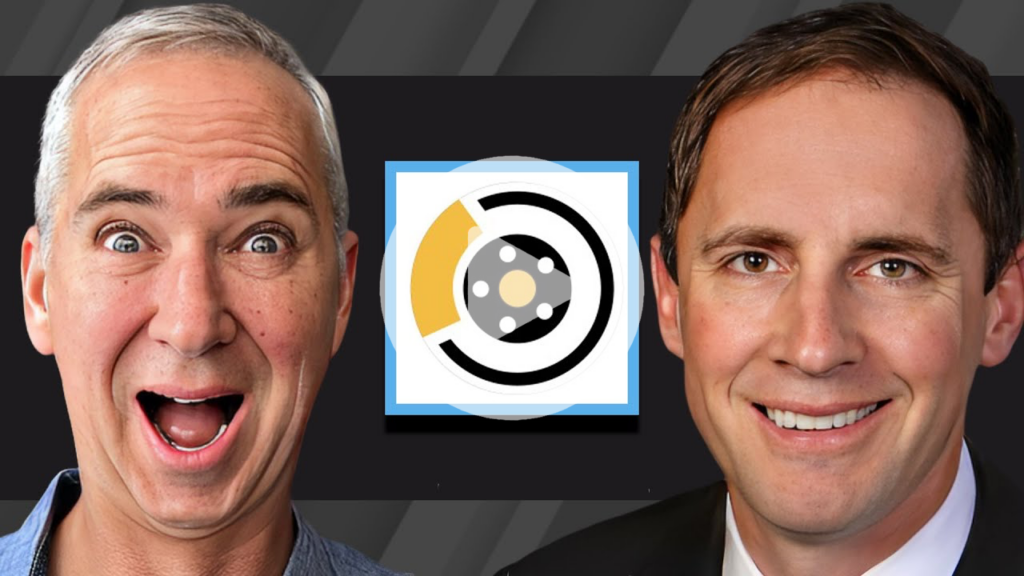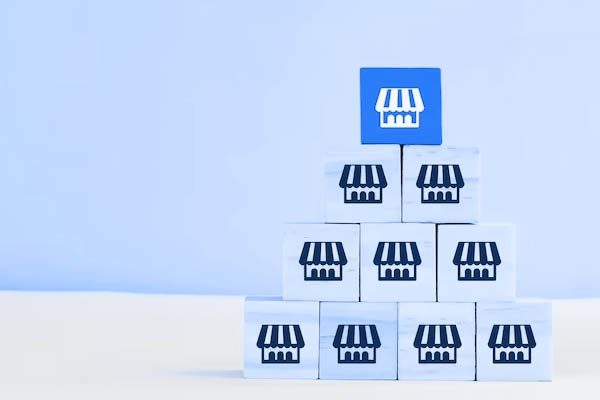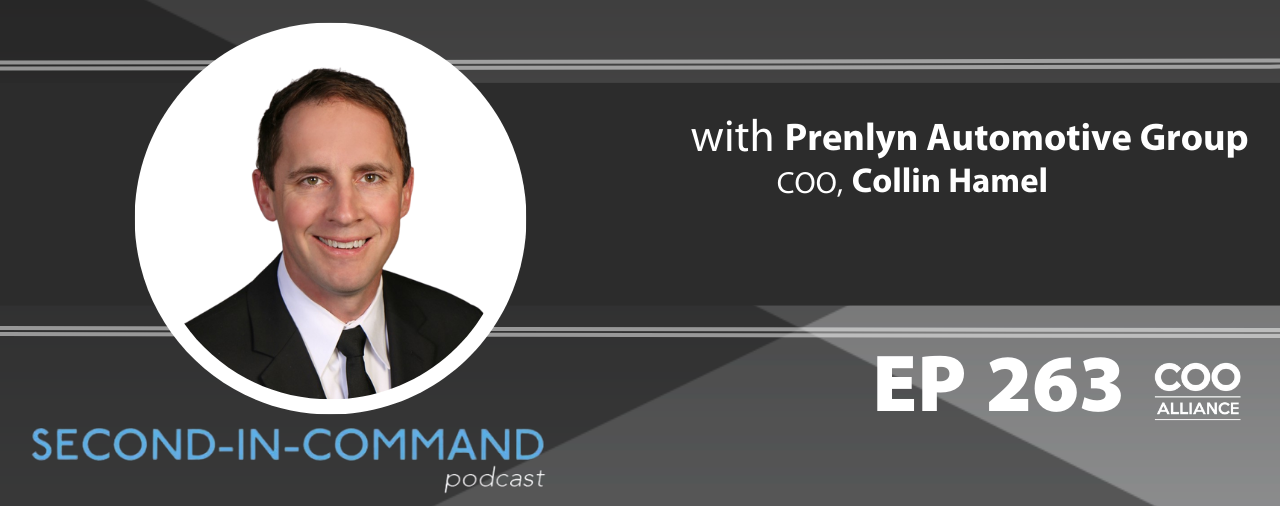Collin builds high-performing organizations by focusing on developing people, processes, and planning. He learned to leverage his experience leading small teams within an elite Marine Corps unit as well as his time as an officer in the Army Special Operations to turn regular organizations with normal leaders and team members into motivated and engaged high-performing teams. He also worked with the Special Operations Transition Foundation, a charity organization that places people with special operations backgrounds into the business world, where they can leverage their leadership skills. From there he moved on to the Prenlyn Automotive Group, which is a family-owned company that currently operates 30 Midas Tire and Auto franchises throughout Philadelphia, Allentown, and Central New Jersey. The company’s core focus is to inspire growth, and they strive to go above and beyond for their clients no matter the challenge.
In This Episode You’ll Learn:
- How Collin transitioned from the military to the real world.
- His work with the Special Operations Transition Foundation.
- The benefits and challenges of working within a franchise organization.
- How to overcome the fear of feeling like an impostor.
Resources:
Connect with Collin: Website | LinkedIn
Special Operations Transition Foundation
Connect with Cameron: Website | LinkedIn
Get Cameron’s latest book “Second in Command: Unleash the Power of your COO”
Subscribe to our YouTube channel – Second in Command Podcast on YouTube
—

Watch and Subscribe to our Podcast on Youtube
We have an interesting episode for you that you’re going to enjoy. Collin Hamel is the Chief Operations Officer of Prenlyn Automotive. He came out of the Special Operators Transition Force, which is a group that takes people from the military with high-level military experience and brings them into the operations side of businesses. They’ve got an intriguing program that he’s going to talk to us about. He is also going to talk about their use of the systems of scaling up and EOS Traction.
He talks about his focus around driven results, how they’re operating 30 Midas stores, and operating in, frankly, a market where it’s tough to hire a lot of the key employees that you need to be out there working in the automotive shops. He also talks a little bit about some intriguing payment plan options as well, where they figured out some of the core friction in their model of getting new customers. You’re going to love the episode. We’ll see you on the inside.
—
Collin, welcome to the show.
Thanks for having me. Congrats on the millionth episode mark that you guys have been rolling through. You guys are doing a great job.
Thank you very much. That was a big milestone that we hit. I wasn’t even aware we were coming up on it. I knew we were over 750,000 but somehow, we started to even leapfrog dot. The guy on my team, Jason Torres, who’s been running and managing all the episodes for me since day one announced it as a surprise. It was a good surprise.
When you hit the compounding growth phase, you are in the slow slog and then all of a sudden, hit your stride, that’s awesome.
I am looking forward to learning from you. You’ve got a pretty unique role. I learned about you when I was on your CEO’s podcast, Brian Beer Podcast, about my new book, The Second in Command. He was telling me about the group of automotive shops that you run, the business that you’re in, and then also the uniqueness of the family enterprise. I’ll ask some questions about all these things. I was curious to get the second in command’s perspective so thank you for showing up. I appreciate it.
I’m glad to join the team here.
What was your background in getting there first? We’ll start with that and then I’ll go around a little bit. How did you end up in this role there with the Prenlyn Automotive Group?
What you would consider an atypical way of getting there, I spent my formative years in the military as an enlisted marine. I went to college and then did sixteen years as an Army officer within Special Operations and infantry units. As I was transitioning out, I happened into a phenomenal organization, Special Operators Transition Foundation. It’s a charity that places people with special operations backgrounds into the business world where you leverage a lot of your leadership skills and then fill in a lot of the gaps quickly that you might have on the business side. I ended up getting linked up with Brian and Chris through SOTF, the abbreviation. I ended up starting and have been the COO of the company since then.
That’s an amazing journey when Brian mentioned the Special Operators Transition group. What were the core skills or the core training that they gave you to transition from the military operations side into the private sector military side? Were there also some skills around running companies that they gave you as well? It sounds like a bit of a real-world MBA.
A lot of it is trying to figure out. It’s strange to describe but when you’re in the military, you create options for yourself by your performance and then more importantly, the performance of your team and what you’re able to do. Whether that’s leading 4 people, 400, or 4,000, you produce options for yourself. In the end, the Army has its plan and gives you the options.

Franchise Organizations: When you’re in the military, you create options for yourself by your individual performance and, more importantly, the performance of your team and what you’re able to do.
One of the biggest issues that veterans have is when they transition out of the military, especially if you are combat arms, an infantry guy, a ranger, Special Forces, a SEAL, or even a tanker where you’re driving tanks around. There is no civilian equivalent of infantry guys attacking a hill that sees an objective. You have a lot of intangibles but the biggest gap is you lack some of those hard skills.
You’ve got probably decades worth of leadership experience crammed into the 4 to 20 years that you did but you lack some of those hard skills. You have to try to find the right position and the right job that is interested in finding their integrator or the person that can be thrown into a situation, make things happen, develop relationships, develop a team, and build cohesion to achieve desired end states.
The biggest thing that SOTF does though is it helps you focus on what that is. There’s not a linear one-to-one transition. You spend a lot of the time looking inward for the first time in your career. It could be 20 to 30 years from the first time you looked inside and said, “What do I want to do? Do I want to work with four people in the same room every day? Do I want to work with 200 and go to 30 different locations a month? Do I want to work be it inch-wide and a mile deep at Exelon, Pico, Amazon, or any Fortune 500 company?”‘
Most of the time, when veterans get out, you think of a Fortune 500 company. 80% of the jobs are resident within companies that are 200 people or less. Those are the companies that you can’t find unless you know somebody or network, do a ton of information calls or LinkedIn, go back to your hometown or wherever you want to settle or go to different organizations. You’ll never find those like I would’ve never found Brian and Chris Beers, the owners of 30 Midas locations from Fort Leavenworth, Kansas, which is right outside of Kansas City.
Do they operate a little bit like an executive search firm and a training group as well? Is that the hybrid that they would run?
Yes. They have people like Melba Holliday, an outstanding performance coach for executives and C-Suite level business. They utilize their services to help run through all the personality tests and determine what you want to do and where you want to do it. There’s another team that helps link you up. We’re lucky enough to have a ton of patriots in the United States. There are tons of business leaders that recognize that they have a financial need to find people of talent, not necessarily me but people with actual talent.
Also, they want to give back. They live in a great nation and they’re proud so for them, they want to give back also. It may not be giving you a job but it may be linking you with Tony, Frank, Tina, Alexandra, or somebody that does need it. It’s all about networking. It’s no different than getting a regular job but it’s a little bit more time-consuming. Coming out of the military, your resume is never going to make it past. The open secret is my resume would never make it past a Fortune 500 company because a lot of the KPIs that they’re looking at for somebody, I’m not going to make it through the AI or computer.
That’s what I’m curious about as well. You have been able to do that transition. What was the transition like for you to leave the military income into the business world? What did you have to unlearn and what did you have to learn?
It’s as much about leveraging your strengths and then figuring out where you’re weak at. Like any military operation, I went into planning. About two years out, I made the decision family-wise. I’d done 8 deployments and had 3 kids. I wanted to be a little bit more physically present and then probably mentally and emotionally present with them.
I made a final move to Fort Leavenworth, Kansas to a job that would be feast or famine. I’d be gone about 135 days a year but then, when I was back, I would have a lot more time and predictability. I would be more of one of the cogs in the wheel versus the cog turning the wheel. It was a great opportunity. I have about a year and a half where if I wasn’t gone working, I had a lot of time. I started canvassing. I read about 5 or 6 transition books.
I did about 115 information calls with people from LinkedIn, family, friends, friends of friends, and people that I had met. It was everything from the power and energy industry to retail to Wawa to anything out there trying to find an opportunity and where I fit best. Luckily enough, at the end of my transition, I had one of my old squad leaders from the Ranger Regiment recommended that I talk to the SOTF organization.
A lot of times, even despite what you’ve done in the military, everybody has Imposter syndrome. I thought, “There are people that need it more than I do and deserve it more than I did.”‘ It wasn’t something that I considered until he put me in contact with the organization and they ended up accepting me. I ended up doing about 5 or 6 months with them. They give you an exercise each week and then you get feedback. You then figure out where you want to focus on industry-wise and geographic-wise, and then they start networking you with the people that they know.

Franchise Organizations: Everybody has imposter syndrome, and we tend to think there are people that need things more than we do and that deserve them more than we did.
I did FourBlock, which is another military transition program in the Philadelphia area. It’s another program where each week, you meet with a different Fortune 500 company for twelve weeks and then you get a bunch of introductions to people. I did that and then ended up interviewing Brian and Chris. For me, I tried to leverage my strengths, which are leadership, planning, people processes, and training.
As they were looking to scale their business, that was one of their biggest gaps. Brian is a brilliant thinker and planner. He can visualize the future and where he wants it to be but he’s only one person. He was looking for somebody to be down and in and spend 98% of the time focusing on developing the internal portion of the organization. You classified as the coach portion in your book. He has to be 100% down and in so that he can focus on where we go 6, 12, 18, 3, or 5 years from now.
I took one of the certificates from Cornell on finance, which is a three-part course, to get spun up on the KPIs and everything that I didn’t know and learn what credit and debits are, not your credit card. That was a good bridge there. I ended up doing a two-month internship with a world-class entrepreneur, former VP of Good Year that ran a Big O Tires, a $6 million operation. It is one of the biggest in the nation in Topeka, Kansas. I got a world-class view and everything. I swept the floors, filed paperwork, or whatever he needed but got a world-class education for two months.
You said something about the military that was interesting. You have to make opportunities for yourself in the military. It sounds like everything you did post-Military was exactly that as well. You were trying to make your opportunity. I’d imagine a lot of people don’t put in this kind of work at all to try to find a great career move.
Like everything in the world, you get into what you put out of it. If you asked me if I wanted to talk to 115 strangers, try to win them over, show that I had some potential, get them to introduce me to somebody else, and build relationships and everything, that probably would’ve been the 115th thing on my list to do. It’s all about discipline. I’m weak in many areas but I can do the hard, arduous things sometimes that I don’t want to do. I can force myself to do it. That preparation is what can make veterans successful in transitioning into non-linear job fields if they put the work into it. A guy got extremely lucky with SOTF.
You found the right path but you made your luck as well. What do you think it was that Brian and Chris noticed in you that had them take that leap? Had you worked in the automotive space before? Had you worked in this industry even before as a kid or was this all new as well?
I worked in food service and at Abercrombie & Fitch, folding clothes when I was a kid. In college, I worked at an oil pipeline company. We were walking 3 miles a line for 9 hours a day. I don’t think that I brought any tangible skills that they were looking for. They were looking for somebody that had the ability to plan things. There’s nothing that’s linear but when you compare an Army battalion, I was the executive officer or the IIC of the organization. We had 5 companies of about 120 to 150 people that operated geographically, disaggregated, or separated.
Within those companies, we had 3 to 4 platoons, which are 30 people size elements that operated also independently and everything. When you look at Prenlyn Group, we have 30 stores that are divided into 4 or 5 districts of 4 to 7 locations that are generally geographically near one another but separated. When you look at it, there are a lot of similarities.
When I was the IIC of the battalion or the 600-person organization, I had to set a policy. I wasn’t an expert in any of the areas that I was dealing with, administrative, medical, or whatever the staff components were but I still had to control them and ensure that they were rowing in the same direction as my commander or in this case, the COO or the CEO wanted.
There are a lot of similarities. We had to achieve KPIs. For us, it’s like being ready to deploy for war. You’re trying to figure out those same cogs that you can turn to increase readiness. It is not all that dissimilar to me trying to figure out profitability and mix it in people, processes, and training where I am like, “What can we do to accelerate the growth to grow our top line and bottom line?”‘ It’s different but it’s all people processes and training so there’s a lot of overlap.
It seems like this is a big missing opportunity for a lot of companies in the US to connect with SOTF as well. It’s not just COOs that they can place either. It’s all levels of business that they get to place people in.
There are project managers within the Philly area. There’s another guy, this beast, Derek, that’s doing amazing things, going to Wharton Business School, helping as the COO, and running a real estate empire all around the tri-state area. There’s another guy that’s a local here that’s running the training program for big entrepreneurs. It works great, trying to match a visionary to an integrator. You said it in your book. You don’t have to be a subject matter expert but if you understand how to run organizations, plan, lead, develop, train, and hire, then you can make it happen.
You mentioned the integrator a couple of times. Do you follow the EOS, the Entrepreneurial Operating System, by Gino Wickman, and the book Traction or is this something you’ve picked up and learned along the way?
We did. Between my first and second interviews, they mentioned it on the phone interview and then I read it seven days before we met in Philadelphia. It was between that and Rocket Fuel. You mentioned this in your last episode, Scaling UpThat is what we started transitioning more to. It’s a little bit more nuts and bolts. It’s where we’re trying to go. We’re at 30 trying to grow from here.
How many employees do you have across the 30 locations?
We got about over 200.
You’re at a size when scaling up starts to make sense. When you’re less than 50 to 70 people, scaling up is almost too complicated. The systems are too much. That’s where EOS tends to break down as well. It’s a good leap that you’re making. What’s it like working with two brothers? The father who started the business, is he still actively involved or possibly involved in the business?
Tracy and Herb were the two original owners and they’re still involved. They’re part-time. They help me out. Herb helps out with some of the maintenance. He is a wiz with all the equipment and everything so he helps out with that. Tracy, as we get new locations, helps integrate them. She helps to go around and keep an eye on things and everything.
Brian and Chris are the two brothers. Luckily, they have their distinctive strengths and areas that they focus on. Brian is the visionary of the company and then his brother also. He is mapping out. He is doing a lot of the discussions with other franchisees when we’re acquiring new locations. He is very involved with TBC, the corporation that owns the Midas franchises. He sits in on a lot of the boards and everything.
Chris went to Vanderbilt. He is a big tech guy. He does all our scripts and everything for all our automated reports. He is running the back office as we’re running a transition with our CFO position. He took back over a lot of the backside administrative tasks and everything and has been getting everything in order there. They both overlap in the interest of helping to perform the company but they also have a lot of their separate interests so it works pretty fluidly.
What’s it like working within a franchise organization as well? I’ve been a part of a number of them. I was the second-in-command for 1-800-GOT-JUNK? but I’ve never worked on the franchisee side at such a large company franchisee. What’s it like being a professionally managed business inside of a franchise group? Are there other franchisees that are your size as well, like groups of locations? Do you spend time learning with them as well?
We are the 3rd or the 4th largest franchisee. There are ones that are upwards of 100. We’re the next tier down at 30 locations. It’s probably the best of both worlds because when we take over a location, we already have an operating system. A lot of this stuff is familiar so it makes things a lot easier, streamlined, and everything for the royalties that you pay. You pay a percentage. For that, you get a lot of value.
You get a network of people that are doing the same thing. Among the biggest advantages of being a franchisee is you have a network of people dealing with the same problems and issues generally. If you have a question like, “What are you guys using for your onboarding? What are you using when you’re onboarding new technicians or training technicians,”‘ there are ten other people that have a base document that you can try and look at.

Franchise Organizations: Among the biggest advantages of being a franchisee is you have a network of people dealing with the same problems.
We’ve got Mark Smith down in Virginia that runs a world-class organization that is at the cutting edge of customer service and customer community relations. He is using that to grow the business. Brian talks with him all the time. We have another franchisee that works in the same general area as us. He is on a little bit different side of Philadelphia in South Jersey. It gives us somebody to benchmark ourselves next to if we wonder, “Are we doing all we can with the calls and everything?”‘ We can look at Sam’s group and then figure out where his call volume increased or his sales and GP. There is transparency in a lot of the numbers too. It’s great to benchmark yourself against peers, which sometimes, you can’t do if you’re a single ice cream shop trying to figure out how you’re doing.
It’s interesting you also see the benefits both of being a part of a franchise organization. You even said there are valuable benefits of being a part of it and that’s what the royalties are paying for. Many people have to make that transition. At some point, the royalties are taxed and they are frustrated with it but then, you make the transition to realize you’re part of a 70-year-old brand with a lot of good traditions, systems, and best practices. It makes things faster and easier. I’m glad you recognize that and follow it.
I can’t remember what it was related to but you said something about Imposter syndrome. Our largest members are $1.5 billion in revenue. Our average members are around $40 million. They all feel like imposters every day. What do you do to not feel like an imposter? When that kicks in, which is normal at some point, how do you get yourself through that to be like, “I’ve got the confidence again so I’m going to keep growing?”‘
When I came in, a couple of the people that I work with said, “We wanted your job.”‘ I’m not too focused on myself most of the time. I do have an ego and everything like everybody. I’m extremely focused on driven results and trying to help grow the organization. I hope people don’t think I’m trying to be the best store manager or district manager. I’m trying to be the best COO for the organization.
I’m trying to keep the pulse on the business and see what’s working at some stores. I spread it to the others and then evaluate what is working training-wise at one district and apply that to the others. You’re the accelerant that accelerates growth from one district to another and does not have silos. It creates a team effort. When I focus on helping the team, I’m not worried about myself or my insecurities. I try to focus down and let everything else work its way up.
How about you and your skillset as a leader? What are you focusing on to grow as a leader? Do you have any specific areas that you’re working on getting better in?
The KPIs were a steep learning curve. For us, it’s all these cogs that turn the cogs. For me, I’m trying to figure out all the relationships. There’s an aspect of technology that I’m trying to figure out with R.O. Writer, which is our POS order-taking system. I’m trying to get better at that. I’m not trying to be the best store manager but if I’m in a store and it’s busy, I want to be able to check people in and help them.
For us, financing is key. We know that the economy is changing. We are providing people the opportunity not to have to come out of pocket $2,000 or $3,000 when 80% of the population doesn’t have over $400 for emergency purchases. I throw myself out there. I start talking to the customers about payment options and payment plans that we offer. We try to make it affordable for anybody to get home safely and drive their family safely. I’m trying to get better at that and the overall business.
Brian is slowly bringing me into some of the acquisition sides. They’re trying to figure out when other franchisees are trying to exit the business how we do it, the costs, and everything. The last thing is the financials, like understanding the fixed and variable costs. Labor is the big one but it is understanding what we can do, saving through my training program so we can save on workman’s comp, and preventing accidents, injuries, and all this stuff. I’m trying to figure out all the different cogs that can help us help more customers, put more money in our team’s pockets, and grow the business.
I like the focus on it as well. You mentioned the labor being the biggest component of the overhead of the cogs. Is it tough to hire trades? How are you finding good people in this space?
If you got any hints, I’ll take them. The biggest challenge we have is people. We see it frequently in our stores. We’ll have a store that’s doing $12,000 a week and then we change the manager and the store goes up to $25,000 a week. The four walls are the same. The couple hundred thousand dollars worth of equipment is the same. The tools and techs are the same. People matter. In your book, you talk about a key role of the COO is to try to get not C minus to B talent but to get the top talent in there. We see that it pays dividends.

Franchise Organizations: A key role of the COO is to try to get the top talent in there and you know, like we see that it pays dividends.
For us, on the management side, we’ve seen great success in networking. When we find a great leader that joins as a store manager, we try to ask them after they have established a track record within the company. We’re like, “Do you know anybody else that would be a great fit for our organization?”‘ We’re not everybody’s cup of tea. We have our focus on how we run the business. We want people that can come in and excel in that environment. We do have high expectations so we do try to match with people that want to help more people and grow. It is a smaller pool that we’re looking for.
Networking has been key for us. With the trades, one aspect is we try to keep the people that we can and we try to do that by incentivizing. For us, we have uncapped pay for managers and our techs. We have techs that make way more than most of the rest of the organization each week because they do exceptional work and quality work and help a lot of customers. We are paying for performance and incentivizing.
We try to incentivize at all levels. Once they reach a certain amount, every dollar gets divided up among the leaders in the store and the techs in the store. We find that if you do that and then try to make a great work environment, then you keep the good people. The people that don’t match with us, we try to not make them miserable and make them conform to what we want.
We try to provide them the opportunity but then, if they’re not fit, we know that everybody is capable of being exceptional somewhere but it might not be for us. It might be at a mom-and-pop store. We try not to make them miserable. We have high expectations. We want to grow and help more customers. If you don’t want that, there’s a mom-and-pop store down the road that would probably be happy doing 5 to 7 seven customers a day. You would be the best manager for that store owner that could pull out of the business. They’d be happy.
There’s probably a government automotive shop. You can go work for a government automotive shop and they’ll be happy.
Finding the right people is the hardest part. There are people out there but we are finding the people that it’s a win-win for us and them. We want them to be happy working for us. We want them to come in energized and pumped up every day. Not every day’s going to be amazing but we want them to be excited.
I’ll give you a quick bonus tool to help on the recruiting side that a lot of our COO Alliance members have started using. What’s the rough total comp that one of your guys in the shop is making annually?
The techs range anywhere from probably $45,000. They could make into the six figures. We have techs that are making significant money.
Let’s say that it’s $60,000 a year for easy math. $60,000 a year is what the average tech is making in the shop. You put a bonus in place for any of your current employees who recruit someone to come and work for you, whether it’s from a competitor or somebody they know in the industry, or any of their friends.
Anybody that they recruit that comes to work for you, they’re going to get a $30,000 bonus. They’re going to get half of the annual comp of the person, which is $30,000. It’s going to get paid out $6,000 a year, 5 years in a row as long as they are still with the company and as long as the person they recruit stays with the company. It’s paid out at month 12, month 24, month 36, month 48, and month 60. It becomes an incredible recruiting advantage for you.
It also becomes a point of retention for both people. You can have some assurance that they’re going to at least stay until the twelve-month mark. When the average lifespan of an employee is around 2 and a half years, your total real exposure is only about $12,000 to $20,000. The reality that you can bring in this big pipeline and pay the people that you’ve got a little bit more keeps them happy too. It’s an interesting model if you play around with that.
We’re going to look into that. We’ve been doing something on a micro-scale, doing a couple of hundred dollars, like $30,000, $60,000, and $90,000. That’s interesting. I didn’t think about the larger domain.
It has to be a much larger amount. It’s half the value paid out over 5 years paid at the end of each 12-month period. It becomes meaningful and then these guys are chasing it down. When it’s a couple hundred, it’s never meaningful enough so it never works. Play with it, try it in one random city, and see if it goes before you roll it out system-wide.
You talked about the franchise repairs and the payment options. It’s intriguing that you’ve seen that friction point in the business and you’re trying to remove that friction point. Are you running that payment option internally or are you using an outside payment agency that’s working with you on those or both?
We have four ways to pay. We have the Midas credit card, which is a great option for people that have good established credit. There are different advantages in membership rewards that they can get for doing that. We offer three secondary financing so like a buy now, pay later, that’s run through other companies. If the customers don’t pay it off in 90 to 101 days, then they accrue the interest and then they benefit from that payment scheme.
For us, we know that everything’s expensive. Taking the kids to Chick-fil-A is $60. Automotive repairs are the same. The brakes are very expensive. People need their cars. Lower-income people predominantly work in in-person work fields. It’s essential that we provide options to get them back on the road safely. I was out at the store and a guy got towed in. He declined the work to include a battery, and the battery died so he had to get a $300 tow job to our location. He had to get the $1,500 in repairs to his car. He paid $1,800 instead of $1,500. I feel like, in some ways, we failed him because we weren’t able to provide the options that he needed to get them done at the time. He ended up having to pay them anyway and pay an extra $300.
When you talked about acquiring other franchisees, how much of your growth is going to be through acquisitions, and how much of it is going to be organic?
The long-term growth is all driven by acquiring other franchisees that are looking to exit the business. In a lot of the service-based industries, there are a lot of Baby Boomer generations that maybe their kids want to work at Instagram or Meta. They don’t want to go into the blue-collar field. A lot of them are tired of dealing with the stuff that we’ve been talking about, like personnel, training, automation, and everything so they’re looking to exit.
That’s the other advantage of the franchisee model. It’s a very fast transition. Systems are 90% the same. The way that we drive the sales processes is a little bit different but all the automation and everything are the same. Within 30, 60, or 90 days, we can take over a company of anywhere from 3 to 11 shops and have them up and running and installing our process.

Franchise Organizations: The other advantage of the franchisee model is that it is a very fast transition. The systems are 90% the same.
Organically, we’re looking to grow about 15% in 2023. For us, there are a couple of key drivers. We can either sell more per ticket or see more cars. We choose both. In the end, everything that we’re recommending is either safety stuff or maintenance stuff. It’s either your stuff’s broken or you do this maintenance. Don’t wait until you have a heart attack to start walking and eating your vegetables. It is the same thing for us. Don’t wait until your car has broken down.
A lot of it is explaining why and building rapport. It is all the general same thing for the sales process. If we can help more people get out of there safely and they’re driving on the same roads you and I are, that’s a win for everybody. For us, by getting more cars in and being better on the phones and internet appointments, we’ll be able to help more people, put more money in our team’s pocket, and then grow the business.
I like it. It makes a lot of sense the way you’re thinking about it as well. I have a question about the automotive industry itself. Is there any threat or risk in the industry with so many of these vehicles becoming autonomous vehicles or electric vehicles? Is that reducing the maintenance or the repairs and the work that you guys are doing or is there still such a big market out there that it doesn’t matter yet?
The average vehicle on the road is eleven years. Even with ICE vehicles, Internal Combustion Engines, we have a long runway. We want to be at the cutting edge of the technology and the transition. It does require equipment upgrades. You have to have different pads on the lifts because you have a massive battery shelf that’s on the bottom of the car instead of the engine.
We do have to do some lift conversion and be able to get some lifts that can lift heavier things. Nobody knows how the battery, exchange, and everything is going to work. They also do burn through tires faster so there’s an opportunity because of the heavy weight of the vehicle. TBC as a corporation is looking at how to stay ahead of the curve and how to be able to help all the customers. There is a long runway but we don’t take that for granted.
Let’s go back to the 21 or 22-year-old you. Maybe you’re just starting in the military or business. What advice would you give the 22-year-old that you know to be true now but you wish you’d known back then?
I’ve been so lucky in my life that I’ve happened in the right situation with the right people. If my kids were 21 or 22, or for myself, go to the best organization you can get into and get the best mentor that you can. People are going to disagree with this but work the most amount of hours that you can be learning during those early years. There is going to come a time when you don’t want to be up at midnight grinding, trying to learn something when you’ve got three young savages running around your house. You’re throwing Pokemon cards everywhere, going to sports, and everything. If you put that time in early, then it’s your baseline.
Maybe you are working 3 or 4 days a week for a couple of hours or you got a half working Friday and everything. It’s hard to go up. It’s easier to go down. It’s no different than physical fitness. Once you can run 3 miles, then 4 miles is easy. That’s a hard thing to do. I was lucky that I joined the military. You don’t have a choice. You’re going to immediately deploy after 9/11 and the invasion. On my first deployment as an officer in the Army, I deployed for 15 months where I worked every day except for 4 days. I had a 10-day leave when I came home but I worked every single day for 10 to 18 hours a day. After that, everything’s easy. That’s what I’d say. Get to the best organization you can.
I love that the baseline that you’re building becomes compounding as well. It sounds to me that one of the best organizations you got involved with was also the SOTF. Thanks very much for sharing with us on the show.
Thanks, Cameron.





